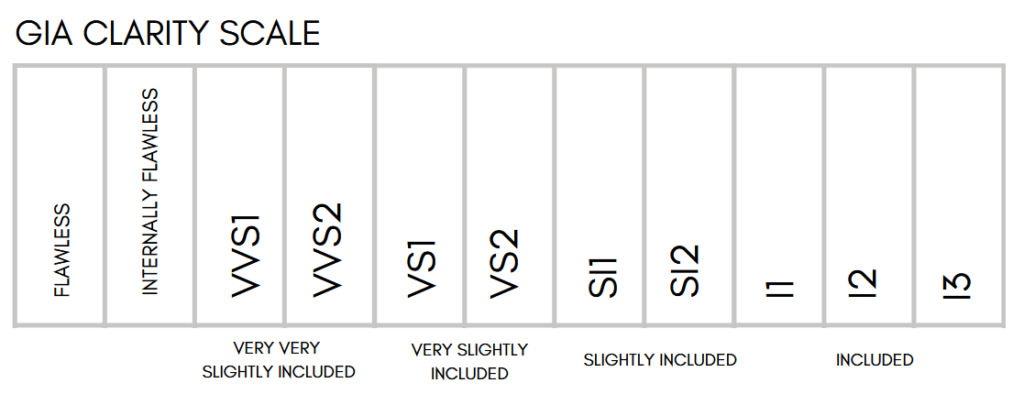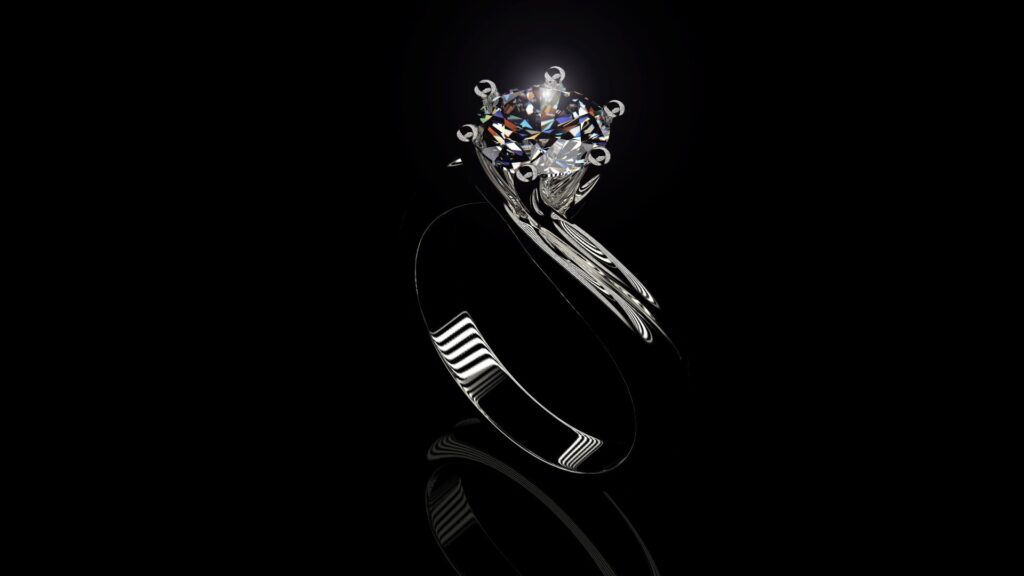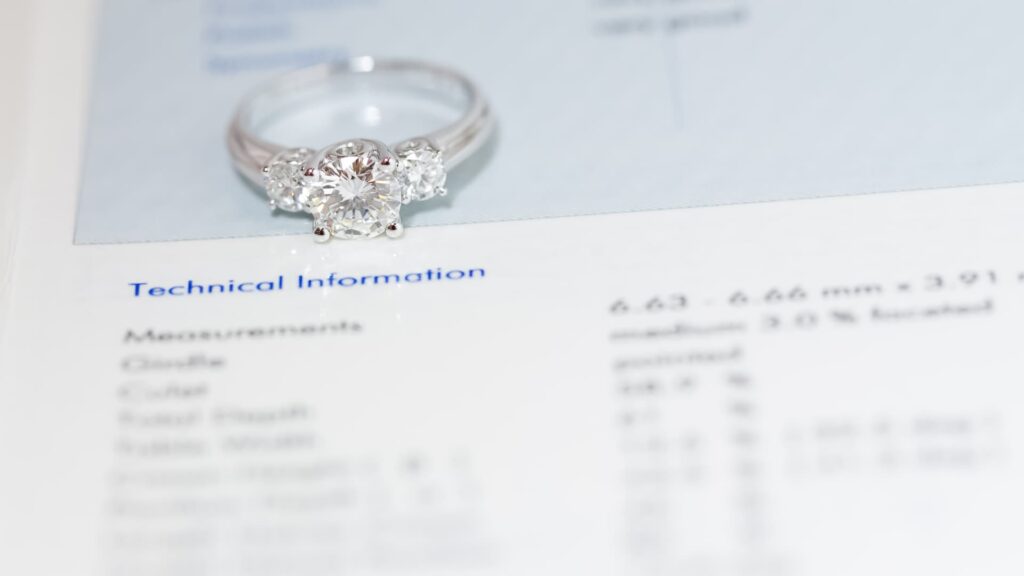The inclusions and blemishes in a diamond affect the amount of light that passes through it and consequently affect the diamond’s light performance and sparkle. Therefore, paying attention to the diamond’s clarity is indispensable.
The amount, location, nature, and impact of these inclusions play an integral role in deciding the clarity grade of a diamond. The clarity grade of a diamond is assessed on the basis of the GIA clarity scale, which looks as follows:

Diamonds that receive a grade from the lower end of the scale (SI – I) have more noticeable and impactful inclusions. At the same time, the ones that stand superior to these have inclusions that are barely noticeable.
Anyway, contrary to popular opinion, a superior grade doesn’t always mean better. You can find a VVS diamond identical to a Flawless diamond, so it’s just about finding the best bang for your buck.
Let’s do that as we compare diamonds from two categories that stand poles apart from each other in terms of their features and performance.
What is an SI diamond?
SI refers to the ‘Slightly Included’ category of the GIA clarity scale. It is the fourth category on the GIA scale and is preceded by the VS, VVS, and F range.
The SI range further encompasses two clarity grades, SI1 and SI2, referring to ‘Slightly Included’ to the 1st degree and 2nd degree, respectively.
An SI diamond shows visible inclusions and blemishes. These imperfections in the diamond are usually large in number. If not that, then they’re definitely more impactful.
An SI diamond can show imperfections like twinning wisps, feathers, pinpoints, clouds, and other high-impact inclusions. These inclusions may not always be a huge problem unless they’re located near the surface or under the table of the diamond.
Anyway, inclusions are easily visible to the naked eye, especially in SI2 diamonds, in most cases. Finding eye-clean diamonds can be quite a task when you’re browsing through the Slightly Included range, but it’s surely not impossible.
What is a VVS diamond?
VVS refers to the ‘Very Very Slightly Included’ category of the GIA clarity scale. The VVS category stands second on the GIA clarity scale and is preceded by only the Flawless Diamonds.
Inclusions in VVS diamonds are hard to identify under 10x magnification, even for a skilled grader. This means the inclusions in VVS diamonds are barely noticeable, and their identification is close to impossible for an untrained eye.
The VVS category includes two clarity grades, i.e., VVS1 and VVS2, which refers to ‘Very Very Slightly Included’ to the 1st and 2nd degree, respectively.
The VVS1 grade stands only one grade below the Internally Flawless diamonds. An unaided eye will hardly ever be able to discern between a VVS diamond and a Flawless diamond. And that means you can save yourself from paying the premium while still getting your hands on the perfect diamonds.
A VVS diamond usually shows inclusions like feathers, clouds, and indented natural. However, these inclusions have a minimal impact on the performance of the diamond.
Are VVS Diamonds Real?
Yes, VVS diamonds are real diamonds. VVS is a diamond clarity grading scale where diamonds are graded based on the number, size, position, and type of inclusions that they have. Diamonds that are rated as VVS have very small inclusions and are considered to be very rare, making them more expensive than other lower-grade diamonds.
What Is The Difference Between SI And VVS Diamond?
The VVS category stands 2nd while the SI range stands at the 2nd last position on the GIA clarity scale. So there got to be many differences between diamonds that receive grades from these categories.
So let’s take a look at the primary differences between them.
SI Diamonds have more inclusions.
SI diamonds show more inclusions than a VVS diamond, and that’s quite obvious, given the fact that these categories are far apart from each other on the clarity scale.
Slightly Included diamonds are from the lower end of the scale. And that means these diamonds have more inclusions and are easily visible under magnification or even to an unaided eye.
Not only are these inclusions greater in number, but also they’re more impactful. They affect the overall performance of the diamond and hinder its light performance. Additionally, these inclusions can make the diamonds more prone to damage and hence, less durable.
Take, for example, the GIA report of a VVS2 diamond:
In contrast, here’s the GIA report of an SI2 diamond:
You can easily spot numerous inclusions in the SI2 diamond in the 2nd image, while the VVS2 diamond has a negligible amount of inclusions.
VVS diamonds show inclusions that are barely noticeable even under the jeweler’s loupe. You practically cannot tell a Flawless diamond apart from a VVS diamond.
On top of that, these VVS inclusions often have little to no impact on the diamond’s performance. And that is one very basic difference that sets it apart from an SI diamond.
VVS Inclusions are hard to identify
A VVS diamond sure is not flawless, yet the inclusions in a VVS-graded diamond are hard to identify, even for a skilled diamond grader.
After a few back-and-forth examinations, only a professional grader can spot the inclusions or blemishes in these diamonds. An untrained person might consider a VVS diamond as an F diamond even under magnification.
Take a look at this VVS2 diamond:
You probably cannot spot any flaw, right?
However, the GIA report of this diamond does reveal pinpoints, feathers, and natural inclusions.
On the contrary, a Slightly Included diamond shows visible inclusions and blemishes. These inclusions may not always be visible to the naked eye. However, under magnification, anyone will be easily able to spot flaws.
Now while the SI inclusions may not always be visible to the naked eye, they still affect the diamond’s performance to a great extent.
Here’s an image of an SI1 diamond:
If you closely examine this image, you may notice multiple inclusions, like the dark blotch around the table referred to as ‘knot’ in the GIA report, and multiple other things, including clouds, feathers, cavities, needles, and crystals (not all visible to an unaided eye).
VVS Diamonds are expensive
VVS diamonds are close to flawless, and so they fetch a value accordingly. They are one of the most prized categories of diamonds and are known for their best performance.
VVS is a superior diamond grade that shows minimal inclusions, and they’re highly desired by consumers. They show an unrivaled scintillation and are great in terms of durability as well. And so they come with a price tag that matches those premium features.
Buying a VVS diamond will cost you an arm and a leg; however, it’ll still save you some money as compared to the Flawless range of diamonds.
In contrast to that, SI diamonds can be your best bet if you’re on a tight budget. You can find some excellent eye-clean diamonds in the SI range, especially SI1 graded diamonds while remaining on a budget.
Since SI diamonds have more inclusions and, consequently, a less promising performance, they fetch a price far lower than VVS diamonds.
VVS Diamonds are rare
Diamonds with lesser imperfections are hard to find, and that is why F-graded diamonds are the rarest of them all. Next in line comes the VVS category.
VVS diamonds are quite close to flawless and show minimal inclusions. So they’re also a rare grade of diamonds. Since VVS diamonds are rare, they are also highly desirable. As a result of that, they are considered quite valuable too.
On the other hand, SI diamonds, like most natural diamonds, show a lot of visible inclusions. They do not deliver exceptional performance, and so they don’t have a lot to do with rarity.
SI vs. VVS Diamond: Which is better?
Well, I don’t think there can be a long debate about that. Both VVS and SI diamonds have their pros and cons. While most people may believe that SI diamonds are more about cons, they can still prove to be a worthy choice at times.
The facts about both these diamond clarity grades are out there.
- VVS diamonds show excellent clarity and minimal inclusions
- They deliver a fantastic light performance
- They are rare, and they fetch a crazy amount of value
- Choosing a VVS diamond means you won’t have to worry about the impact, amount, or location of inclusions
- You don’t have to limit yourself to choosing only certain shapes or small caratage of diamond either, and
- You get a diamond that’s almost identical to a flawless diamond without the premium price tag.
On the contrary, ‘Slightly Included’ diamonds have,
- A greater number of inclusions that may or may not be visible by the naked eye
- When choosing to go with SI clarity grade, you’ll have to struggle to find an eye-clean diamond
- SI inclusions are very noticeable in diamonds larger than 1 carat.
Bigger diamonds show the inclusions and blemishes more clearly, so you’ll have to stay within one ct if you don’t want the diamond to reveal its flaws.
However, if you’re on a tight budget, SI diamonds can prove to be an excellent choice, especially if you succeed in finding an eye-clean piece (which is far from impossible, by the way).
All in all, both SI and VVS diamonds can prove to be an amazing choice depending on your preferences and your situation. However, SI grade is definitely not recommended if you’re going for a diamond above 1-1.5 ct.
Price Comparison: SI vs. VVS Diamond
The prices of diamonds from the ‘Slightly Included’ and ‘Very Very Slightly Included’ range vary largely. And I’m sure that didn’t come off as a surprise to anyone.
Of course, these diamonds vary a lot in their performance. VVS diamonds offer a matchless scintillation, and so they come with a price that matches that beauty.
Anyway, let’s make a little price comparison between diamonds from the VVS and SI categories.
So starting off with diamonds from James Allen. The prices of 2 ct. VVS Ideal cut diamonds in G color grade start from $28,000 and go all the way up to $42,000. This includes diamonds with both VVS1 and VVS2 grades.
For example, take a look at these two ct. VVS2 diamond with similar cut and color grade. It will cost you around $37,690.
In contrast to that, the prices of 2 ct. SI Ideal Cut Diamonds with G color grade starts from $17,000 for an SI2 diamond. And go up to $25,190 for an SI1 diamond.
Similarly, let’s check out the price range at the Blue Nile as well. For 2ct. Ideal cut VVS diamonds; the prices start from $27,128 and go as high as $47,972 for this diamond.
On the other hand, the prices for 2ct. Ideal Cut Slightly Included diamonds start from $18,926 and go up to $28,309.
As you can see, there’s a distinct difference between the prices of diamonds from the respective categories. The flawless beauty of VVS diamonds sure does come with a price. On the contrary, finding an eye-clean SI diamond can save you a lot of your hard-earned money.
Final Verdict
At the end of the day, you’re the one to make a decision for yourself. You can weigh the pros and cons of each of these diamond grades keeping in mind all the aforementioned facts, and find out the suitable choice for yourself. Or you can take the middle road and choose a VS diamond instead!
Related articles:
VS1 vs. VVS2 Diamond Compared






